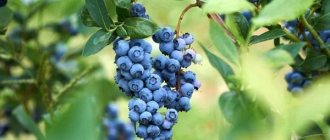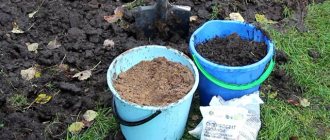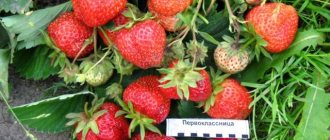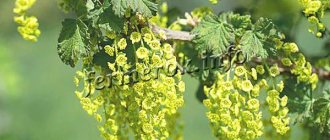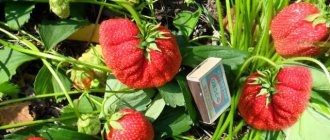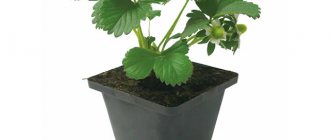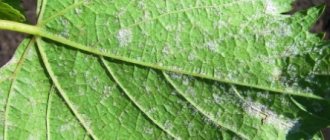Description of the variety
Blugold blueberries belong to the group of tall varieties. This means that not compact bushes about 30-40 cm high will grow on the site, but a full-fledged plant with powerful upright shoots will form. The height of the bush can reach 1.2-1.5 meters. The root system is well developed. However, the roots lie at shallow depths.
The shoots are covered with elliptical single leaves. The small leaf blades have a glossy surface of bright green color. Gold Blue blueberries bloom with charming small bell-shaped flowers of white and pink color, which are collected in inflorescences of 8-10 pieces each.
Interesting fact!
Many gardeners begin growing Bluegold Blueberries as an ornamental shrub. Its bushes attract the eye from early spring until late autumn. First with fresh greenery, abundantly covering the shoots, then with abundant flowering. In the summer, gardeners will be pleased with the earrings of blue berries, and in the fall its leaves will take on scarlet and purple hues.
Garden blueberries, including the Blugold variety, are still a rather rare guest of dacha estates in the post-Soviet space. Most likely for this reason, it did not pass the tests, was not included in the State Register and was not zoned. But the frost resistance and cold resistance of the variety allow us to assume that it will take root well not only in the central and southern regions of the country, but also in the northwestern regions and Siberia.
Most reviews from gardeners indicate that Blugold blueberries prefer to grow in sunny areas with good access to fresh air. It is demanding on soils and the depth of groundwater. It is not so much the chemical composition that is important as the mechanical properties of the soil. It should be light and breathable. It is desirable that it be podzolic in composition, with high acidity. When groundwater is close to the surface, blueberries of the Blugold variety are planted on hills or artificial ridges.
Photos of Blugold blueberries taken at the peak of fruiting show that the entire bush is densely covered with small clusters of berries. The berries are medium in size, and at the beginning of fruiting they are larger. On average, their diameter is 1.6-1.8 cm. Weight is about 3-4 grams. Breeders calculated that up to 70 berries can be placed in a 250-gram container.
Landing Features
When growing blueberries, you must follow some rules. In order for the seedling to tolerate adaptation well and produce a good harvest in the future, be sure to plant it in acidic soil. The plant cannot be planted in peat soil.
If there is no acidic soil, you can plant the bush in mixed soil consisting of several types of soil. For example, pine sawdust, peat and sand. The soil should allow the plant to breathe and allow moisture to pass through to nourish the root system. For planting, choose an area protected from the wind, with good lighting. Water the plant.
If it rains frequently, you don’t have to water it, but in hot weather the berry needs regular watering. Due to a lack of moisture and nutrients, shrubs bloom poorly, reduce the number of flower buds, and this leads to a decrease in yield.
With neutral or alkaline soils in garden plots, you can plant blueberries in a specially prepared hole. Dig a shallow hole approximately 50x50 cm, about half a meter wide. Line the pit with film (PVC) on the sides; add a layer of top peat (substrate), sand, and pine sawdust to the bottom. Fertilizing the soil with pine needle humus will be an excellent addition. Nitroammofoski is added about 30 g.
Blugold blueberries in the garden plot are a very good solution. It is not picky or demanding, bears fruit well and can perform a decorative function.
Characteristics
Among the positive qualities of Blugold blueberry, which are present in the description of the variety, is its frost resistance. Plants in the middle zone can overwinter without shelter under a layer of snow. The root system and shoots can withstand frosts down to –30˚ –34˚C. The Blugold variety is not afraid of slight freezing of shoots. As a rule, the abundant formation of new buds allows the berry crop to quickly recover.
Another nice thing is that Bluegold blueberry flowers can withstand short-term drops in air temperature down to -7˚C. Residents of the middle zone, with its unpredictable weather conditions, will not be left without a harvest even with recurrent frosts.
Descriptions and reviews of Blugold blueberries indicate that it has a lot of other positive qualities. First of all, this is a cold-resistant variety. Its flowers are not prone to forming barren flowers and do not drop their fruits during prolonged cold spells. But hot and dry weather can damage the crop. At elevated air temperatures and lack of moisture, the berries seem to bake in the sun and mummify.
The Blugold variety is self-pollinating and does not need to be planted next to other blueberry species for cross-pollination.
Features of fruiting
Blugold blueberries are a variety with medium-late berry ripening. It begins to bear fruit 3-4 years after planting. Collection begins in the second half of July. Fruiting is friendly. The harvest can be harvested in one go. It is important not to miss the moment, as overripe Gold Blue blueberries quickly crumble. Their ripeness is indicated by the easy separation of the berries from the stalk.
Depending on the conditions, the yield of Blugold blueberries ranges from 4.5 to 7 kg. The number of berries collected is directly affected by:
- soil composition with an optimal ratio of nutrients and acidity;
- pruning excess shoots;
- age of the plant: the older it is, the higher the yield.
Blugold blueberries, thanks to their thick skin, have high shelf life and good transportability.
Strengths and weaknesses of the variety
The variety has gained popularity precisely because of its advantages.
Strengths of Bluegold blueberries:
- ability to tolerate frosts down to -35 °C - the plant does not freeze when planted in Siberia, the Urals and the Far East;
- The bush is self-fertile - it does not need pollinators for full fruiting.
- the ability to produce good, stable yields over several decades;
- good transportability of fruits;
- possibility of long-term storage of berries.
Despite the undeniable advantages, the variety also has some disadvantages:
- the bush does not tolerate drought very well, especially during the fruiting period;
- the crown of the bushes of this variety is highly branched, so it needs more frequent pruning compared to other varieties; if you do not remove excess shoots, the quality of the harvest will deteriorate;
- extreme heat causes the berries to bake and they become mummified;
- The fruits are prone to shedding; they must be collected on time.
These disadvantages can be partly eliminated by more thorough care.
To prevent the quality of the berries from decreasing, blueberries are watered more often than usual during dry periods. During hot weather, the bush is sprayed in the morning and evening. It is necessary to monitor the ripening process of the berries so as not to lose part of the harvest.
Features of reproduction
Blugold blueberries are propagated by cuttings. It is worth considering that two-year-old seedlings are planted in a permanent place. You can try to propagate the bush by layering. In the spring, one of the shoots is dug in and cared for like the rest of the bush. By autumn there will be a good seedling. But it is recommended to plant blueberries in the middle zone in the spring. The question again arises of where to store it until planting.
Most gardeners prefer to buy ready-made two-year-old blueberry seedlings from nurseries. It must be grafted, have two or three shoots with buds and a healthy root system.
Growing conditions
Bluegold blueberries can delight you with their harvests and attractive appearance for many years if you provide them with suitable growing conditions. Since the shrub will grow in one place for many years, it is necessary to take a responsible approach to choosing a site for planting and carry out planting work according to all the rules.
Choosing a landing site, timing
In the wild, blueberries grow in areas with loose, nutritious, acidic soil, so the soil for the planting pit is prepared in advance, adding the necessary additives. Fresh organic fertilizers are never used for shrubs.
Requirements for the site:
- You should not plant blueberries in the place where cultivated plants, especially vegetables, previously grew. Wild herbs are most suitable as precursors for wild berries.
- Another condition for successful cultivation of crops is good lighting. The more sunlight the plant receives, the larger and sweeter the berries will be. Blueberries can bear fruit in partial shade, but in this case the quality of the harvest will be worse.
- The plant does not like stagnant water, so planting in a lowland is not suitable, since in the spring the bush will suffer from flooding with melt water.
- If it is not possible to find a flat area for blueberries, you can plant them on an artificially created hill. In this case, it is advisable to provide the bush with protection from strong winds.
Favorable dates for planting depend on the climate. In Siberia, the Urals and the Far East, in the middle zone, blueberries are planted in the spring, as soon as the soil thaws. In the southern regions, the crop can be planted in the fall; before winter, the seedlings will have time to take root and adapt to the new location. Summer planting is not suitable for any region; it is used as a last resort. This is due to the fact that the shrub does not tolerate heat and drought well.
Preparing the pit, selecting seedlings, planting
The pit begins to be prepared about a week before planting. Its dimensions: depth - 50 cm, diameter - 60 cm. The excavated soil is combined with additives that maintain the desired level of acidity and friability:
- high peat;
- pieces of pine bark;
- rotted sawdust;
- river sand.
The root system of blueberries is fibrous and superficial, which is why the hole should be wide and shallow. A layer of drainage made from pieces of wood or bark must be placed at the bottom. Crushed stone is not used in this case, as it reduces the acidity of the soil, which will harm blueberries.
It is better to purchase seedlings from trusted nurseries. Plants should look healthy. It is better to give preference to planting material with a closed root system. Before purchasing, blueberries are carefully removed from the container and the roots are inspected; they should be branched and light in color. If the roots are bent upward, before planting they are soaked for 1 hour in water, after which they are carefully straightened.
When planting, pre-prepared soil is poured onto the drainage layer, and a seedling is placed on top so that the root collar is 4-5 cm below the soil level. The bush is covered with earth and the surface of the trunk circle is lightly compacted. Then the blueberries are watered, using 10 liters of water in small portions. After planting, the root zone is mulched with a mixture of peat and sawdust or pine needles.
How to plant correctly
Blugold blueberries are planted in the spring. In the southern regions, autumn planting is also possible. It is worth considering that at least two months must pass from the moment the seedlings are planted in the ground until the onset of cold weather.
- Before planting Bluegold blueberries, prepare holes about 50 cm deep and wide. If a drainage layer is not required, the hole is dug to a depth of about 40 cm.
- Drainage is arranged from broken bricks, slate or coarse crushed stone.
- A mixture of soil, peat, sand and pine needles is poured on top in the form of a mound. Add 40-50 grams of nitrogen-containing fertilizers.
- The cuttings are planted on a mound, trying not to bury it.
- Carefully fill with the same mixture. Water and mulch the root circle with sawdust or pine needles.
Harvesting and storage
If the berry easily comes off the stalk, then it is ready for harvesting. There is no point in postponing the moment of picking berries - they may fall off.
Start cleaning after the dew has dried, moving from top to bottom. Place the berries in small containers lined with a paper or cloth napkin.
In this form, the harvest is stored for 12-15 days on the refrigerator shelf; frozen berries are stored for up to 6 months.
Vitamins are well preserved when preparing berry puree with added sugar, but it should not be stored in the refrigerator for too long.
Growing rules
In the first year, the Blugold variety only needs watering and mulching of the root circle. From the second, fertilizing begins. The first is done in early spring using nitrogen-containing fertilizers. During the summer, complex formulations containing potassium, sulfur, magnesium and phosphorus are used.
Pruning of Gold Blue blueberries begins from the 6th year of the plant’s life. It's not complicated. In early spring, before sap flow begins, dried and non-fruit-bearing, as well as thin basal stems are cut out, with the exception of the 2-3 strongest shoots.
Care after landing
During the first year of growth, active rooting will occur. There will be no need to prune the plant in the first 3 years. The fibrous root system of blueberries requires deep watering. That is, you don’t need wet soil, you need water to penetrate into the deeper layers. Therefore, blueberries definitely require drip irrigation. If it is not possible to organize it, try dividing the watering into several parts with a slow pressure and an interval of 15 minutes between parts. This will help saturate the soil to a greater depth.
Apply fertilizer in early spring before buds open.
Feeding will consist of:
- ammonium sulfate - you will need about 100 g per 1 bush;
- potassium - 40 g per 1 plant;
- magnesium - 15 g.
After the bushes bear fruit, the same feeding is repeated. In addition, once every 2 weeks, be sure to fertilize with a solution of colloidal sulfur in the amount of 1 g of the active substance, dissolving it in 1 liter of water and applying it to the root.
Shrub pruning
Like other shrubs, blueberries will perform best if you prune them regularly. For the first 3 years after planting, you do not need to touch the plant, but you must remove all emerging flowers. Remember that the more powerful the bush you form, the better subsequent harvests will be.
Did you know? Blueberries are one of the few fruits whose fruits have a pigment that can color objects blue.
Remember that the more powerful the bush you form, the better the subsequent harvests will be. Fruiting weakens it, as it directs energy into growing berries, resulting in weaker shoots and less developed roots. Starting from the fourth year of growth, pruning is carried out in early spring.
You need to remove:
- all damaged and dry branches;
- intersecting;
- weak and thin, in order to direct the energy of growth to the stronger ones.
You will also need to remove branches from the center of the bush so that the sun shines evenly on each branch and the rays can illuminate the berries on them. Also, in subsequent years, remove old branches to encourage the development of new ones. The old ones have a gray bark, while the new ones are more red.
Diseases and pests
The Blugold variety is resistant to most diseases. In the spring it is recommended to treat it with antifungal drugs. It is worth remembering that even if the plant is diseased, it is not necessary to carry out treatment less than three weeks before harvesting.
Of the pests, the greatest damage to Blugold blueberry bushes can be caused by the larvae of cockchafers, which like to settle in the roots of perennial plants. They are easy to notice when loosening the soil and can be removed.
You can learn about the main characteristics of the Blugold blueberry variety from the video review
Reviews from gardeners
Sergey, 48 years old, Saransk My wife bought Bluegold blueberries - she had read a lot of descriptions and positive reviews on the Internet. And in the photo the bushes look very attractive. They planted two bushes, but for some reason one died. The second one grew and even bore fruit last year. We picked a small cup of berries for the delight of our grandchildren. Now I want to multiply it again so that there are at least 4-5 bushes, otherwise there won’t be any left for harvesting.
Svetlana, 33 years old, Saratov I bought the blueberry variety Blugold a couple of years ago. Haven't tried the berries yet. It just bloomed this year. Very plentiful. The plant became a real decoration of the site. The bushes fit perfectly into the design. In winter I cover it with spruce branches and agrofibre on top. Winters well.
Larisa, 50 years old, Balashikha I have been growing blueberries of the Blugold variety for about 10 years. And every year it becomes more and more beautiful, and the harvest is more and more. In the spring, I thoroughly loosen the root circle and fertilize it with compost, and generously cover it with a mixture of pine needles and sawdust. I don't like peat. Weeds grow through it too quickly. For the winter, I compress the bushes and tie them with burlap. In the summer I only water it, sometimes adding table vinegar to the water. That's all the secrets of a good harvest.
